Pascale Petit's Blog, page 11
December 7, 2010
Mir Mahfuz Ali and the Ten anthology
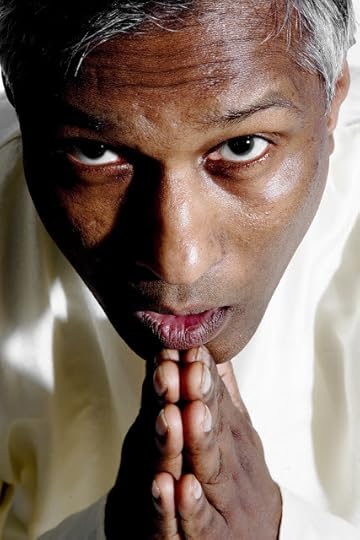
Mir Mahfuz Ali is shortlisted for the 2010 Picador Poetry Prize and is included in the groundbreaking anthology Ten from Bloodaxe. Ten, edited by Bernardine Evaristo and Daljit Nagra, is the culmination of Spread the Word's two year initiative to support talented new black and Asian poets. I had the good fortune to mentor Mahfuz for this project, and what a dream job it was.
Mir Mahfuz Ali was born in Dhaka, Bangladesh in 1958. He grew up during the war of liberation and came to England in 1973, after being shot in the throat by riot police during an uprising. As a performer, he is renowned for his extraordinary voice – a rich, throaty whisper. His poetry has appeared in PN Review, Poetry London, London Magazine and Ambit. He has also been shortlisted for the New Writing Ventures Awards in 2007. His poetry combines a luxurious Bengali linguistic richness with the trauma and first hand testaments of the atrocities of war.
Read his poems in Ten, and all the exciting poets in this anthology, described by Carol Ann Duffy as "ten sparkling new talents who demonstrate the richness, energy and confidence of the poetic voice in our multicultural country". This book is groundbreaking, necessary, but most of all, an enthralling read. Here is one of Mahfuz's poems:
Midnight, Dhaka, 25 March 1971
I am a hardened camera clicking at midnight.
I have caught it all – the screeching tanks
pounding the city under the massy heat,
searchlights dicing the streets like bayonets.
Kalashnikovs mowing down rickshaw pullers,
vendor sellers, beggars on the pavements.
I click on, despite the dry and bitter dust
scratched on the lake-black water of my Nikon eye,
at a Bedford truck waiting by the roadside,
at two soldiers holding the dead by their hands and legs,
throwing them into the back, hurling
them one upon another until the floor
is loaded to the sky's armpits. The corpses stare
at our star's succulent whiteness
with their arms flung out as if to bridge a nation.
Their bodies shake when the lorry chugs.
I click as the soldiers laugh at the billboard on the bulkhead:
GUINNESS IS GOOD FOR YOU
SIX MILLION DRUNK EVERY DAY.
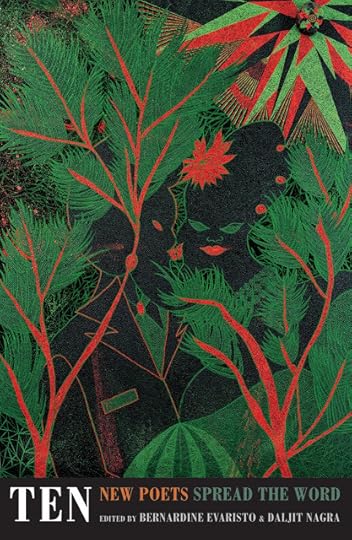
Published on December 07, 2010 15:49
November 22, 2010
Poetry from Art at Tate Modern: Ana Mendieta
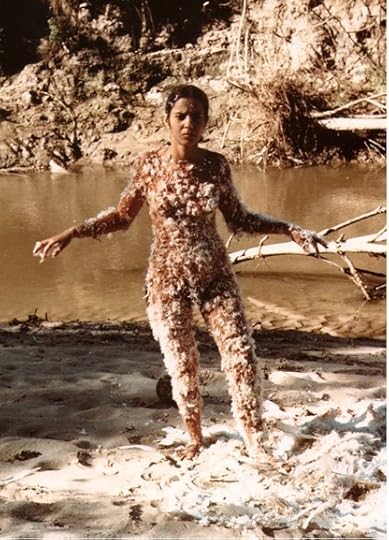
Tonight at Tate Modern we'll be working in the Ana Mendieta room in the Energy & Process wing on Level 5. As Ana Mendieta is from Cuba, we'll read the Cuban poet Nancy Morejón's poem 'Ana Mendieta', which celebrates her spirit and mourns her early death. We'll watch the artist's video Blood and Feathers #2 , where she pours animal blood over herself, rolls onto white chicken feathers, then stands with arms outstretched like wings, on the riverbank.
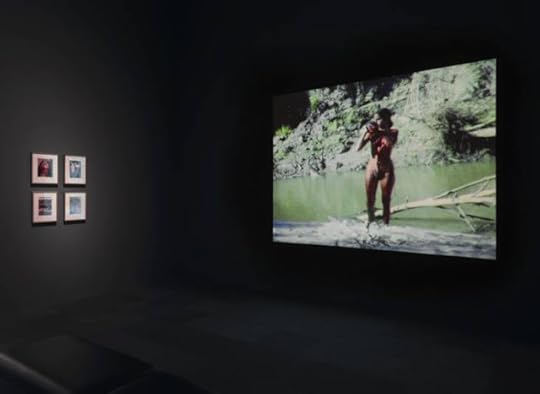
Mendieta was influenced by indigenous Tainan myths of Cuba and the Caribbean and the writings of Carlos Castaneda, particularly The Teachings of Don Juan: A Yaqui Way of Knowledge. I've always been drawn to rituals about transformation into a bird and have written about Amazonian transformation rites in my first and second collections Heart of a Deer and The Zoo Father . Amazonian peoples stick white harpy eagle down feathers in their hair for journeys to their sky worlds.
Tonight we'll also look at the poem 'Animal Dress' by Sharon Olds (from One Secret Thing ) and ' The World's Entire Wasp Population' by Selima Hill (from Violet), as alternative takes on ritual dress, the former celebrating her daughter's coming of age by dressing her in the world's animals, and the latter enacting a ritual of revenge by covering a rival in "this feeling...like jam" then inviting wasps "to enjoy her".
The thirty poets in the group will read the results from tonight's session and their poems from the six week course next Monday, 29 November, at 6.45pm, in the Poetry and Dream gallery at Tate Modern. Everyone is welcome and entrance is free. The other art they responded to are paintings by Gauguin, Joan Jonas' fairytale installation The Juniper Tree and the surreal works in Poetry and Dream. The still below is of another piece by Mendieta Bird Transformation.
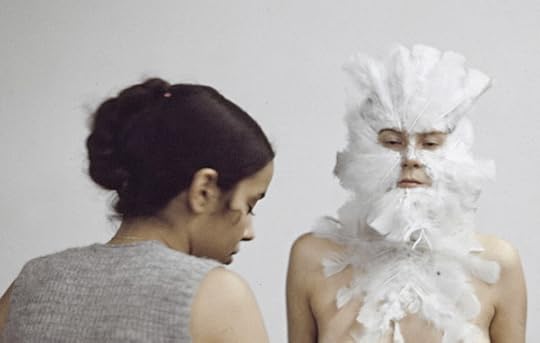
Published on November 22, 2010 10:26
November 14, 2010
Poetry from Art at Tate Modern: a public reading
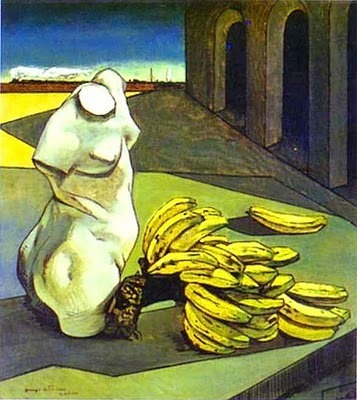 Monday 29 November 2010, 18.45 – 20.45
Monday 29 November 2010, 18.45 – 20.45A poetry reading by the poets who attended the Poetry from Art autumn course, introduced by Pascale Petit. All welcome.
A group of poets has been working in the magical setting of Tate Modern, when the galleries were quiet and closed to the public. Led by award winning poet Pascale Petit they wrote poems in response to works from the permanent collections – Surrealism, Joan Jonas' The Juniper Tree, Ana Mendieta's Blood and Feathers – and from the current exhibition Gauguin: Maker of Myth.
You are invited to hear their poems in the unique surroundings of Tate Modern's Poetry and Dream gallery on Level 3. This event is open to the public.
Tate Modern Level 3 West, Bankside, London SE1 9TG
or call 020 7887 8888
Admission free, no booking required
A publication by the participants from the previous term is for sale in the Tate Modern bookshop. Look out for it in the Art History section of the main shop.

@font-face { font-family: "Times New Roman";}@font-face { font-family: "Palatino";You are invited to a poetry reading by the poets who attended the Poetry from Art autumn course, introduced by Pascale Petit. All welcome.A group of poets has been working in the magical setting of Tate Modern, when the galleries were quiet and closed to the public. Led by award winning poet Pascale Petit, they wrote poems in response to works from the permanent collections – Surrealism, Joan Jonas' The Juniper Tree, Ana Mendieta's Blood and Feathers – and from the current exhibition Gauguin: Maker of Myth. The Uncertainty of the Poet Giorgio de ChiricoYou are invited to hear their poems in the unique surroundings of Tate Modern's Poetry and Dream gallery on Level 3. This event is open to the public.Tate Modern Level 3 West, Bankside, London SE1 9TG or call 020 7887 8888Admission free, no booking requiredA publication by the participants from the previous term is for sale in the Tate Modern bookshop. Look out for it in the Art History section of the main shop.

Published on November 14, 2010 10:17
November 2, 2010
Poetry from Art autumn 2010: Gauguin & Joan Jonas
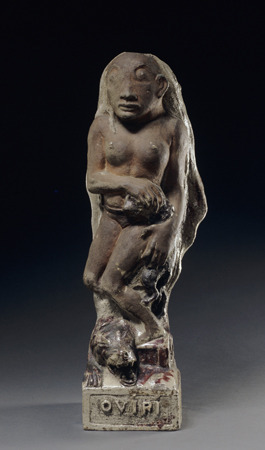
The theme this term for my Poetry from Art course at Tate Modern is myth and fairytale. Paul Gauguin made up his own myths, part derived from Tahitian ones. He created this goddess Oviri as his alter ego. In Tahitian, Oviri means savage – she's stamping on a she-wolf and clasping a stolen wolf cub. Here's the suggestive shape of her back:
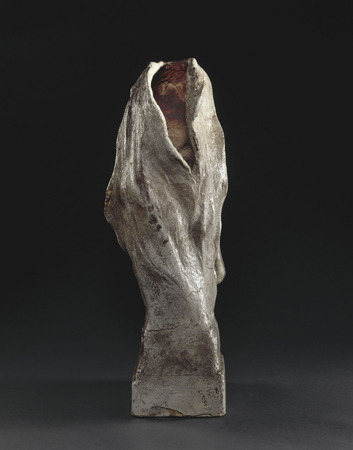
We started the course in the Gauguin exhibition and will return there for one more session. It was amazing to work in the galleries when the crowds had left! In the opening class I supplied lines from Polynesian myths, read out the myth of Hina the moon goddess, which forms the basis of his painting Hina and Tefatou (Moon and Earth)

and read out quotes by Gauguin on the genesis of his painting Manao Tupapau: The Spirit of the Dead Keeps Watch, where he wrote about his use of colour and Tahitian ghost god myths:
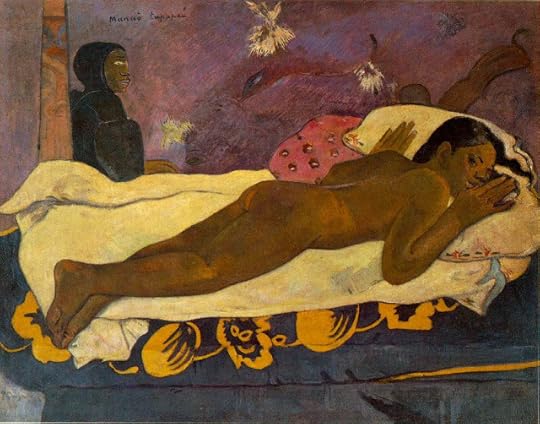
This is what he wrote in a letter about how he painted it:
@font-face { font-family: "Times New Roman";}p.MsoNormal, li.MsoNormal, div.MsoNormal { margin: 0cm 0cm 0.0001pt; font-size: 12pt; font-family: "Times New Roman"; }table.MsoNormalTable { font-size: 10pt; font-family: "Times New Roman"; }div.Section1 { page: Section1; "Here is the genesis: General Harmony. Dark dull violet, dark blue and chrome 1. The draperies are chrome 2, because this colour suggests night, without explaining it, however, and furthermore serves as a happy medium between the yellow orange and the green, completing the harmony. These flowers are also like phosphorescences in the night (in her thoughts). The Kanakas believe that the phosphorous lights seen at night are the souls of the dead. In short, it is a fine bit of painting, although it is not according to nature."
In his journal Noa Noa he added:
@font-face { font-family: "Times New Roman";}p.MsoNormal, li.MsoNormal, div.MsoNormal { margin: 0cm 0cm 0.0001pt; font-size: 12pt; font-family: "Times New Roman"; }table.MsoNormalTable { font-size: 10pt; font-family: "Times New Roman"; }div.Section1 { page: Section1; "One day I had to go to Papeete. I had promised to come back that same evening. It was one in the morning when I got home. Having at that moment very little oil in the house . . . the lamp had gone out, and the room was in darkness when I went in. I felt afraid and, more still, mistrustful. I struck matches and saw on the bed motionless, naked, lying face down on the bed, her eyes immeasurably larger from fear, Tehura looked at me and seemed not to know me. I too was caught for several moments by a strange feeling of uncertainty. Tehura's terror was contagious. I had the illusion that a phosphorescent light was streaming from her staring eyes. Never had I seen her so frighteningly beautiful. I was afraid to make any movement which might increase the child's paroxysm of fright. How could I know what at that moment I might seem to her? Might she not with my frightened face take me for one of the demons and spectres, one of the Tupapaüs, with which the legends of her race people sleepless nights? Did I really know who in truth she was herself? The intensity of fright had transformed her into a strange being, entirely different from anything I had known before."
I asked the group of 30 poets to choose one painting, drawing, carving or ceramic and write a poem about it, responding to the colours, and to incorporate one of the lines from Polynesian myths I had compiled. This could be used anywhere in the poem, and could be altered to suit. They were invited to make up their own myths if they wished, but had to make the poem contemporary and were to be ruthless in writing about something that mattered to them, to be free in their interpretation.
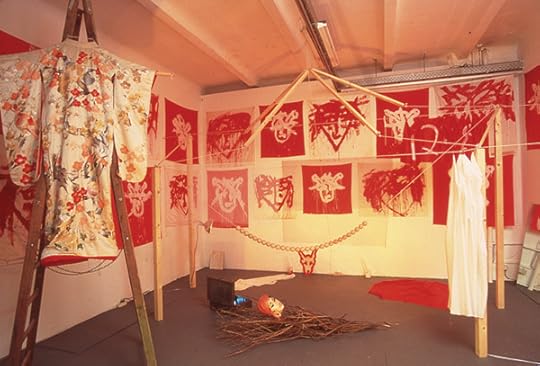
If myth was our focus with Gauguin, for our second week we discussed Joan Jonas's magical but grisly The Juniper Tree installation based on a fairytale. It's a darker version of the Snow White story, and involves a boy who is beheaded then cooked by his stepmother. His bones are absorbed by the juniper tree and transformed into a shamanic bird who sings his story and eventually returns to kill his murderer. The installation is dominated by red and white and a haunting soundtrack. Originally The Juniper Tree was a performance (in 1976 in the US then 1979 in the Whitechapel Art Gallery).
I asked everyone to free-write a response to the installation then offer one of those lines to the rest of the group. We discussed the Grimms brothers' 'The Juniper Tree' fairytale and studied Moniza Alvi's poem 'Mermaid' (from her latest collection Europa ) which is based on Tabitha Vevers' painting When We Talk about Rape – two responses to a fairytale and equally dark subject matter. We paid particular attention to the form of the poem, with its deep indents, the extra space between the spare lines evoking a feeling of shock. Everyone could select one of the group's gift lines to include in a short poem, with attention paid to the form and how it might hold powerful subject matter.
Next week we will work in the permanent display Poetry & Dream. Then we'll be back in the Gauguin exhibition. Our fifth writing session will be in the Ana Mendieta room, responding to an artist who made performances influenced by Frida Kahlo and rituals of indigenous South Americans. Our last session on November 29th (at 18.45) will be a reading open to the public in the East Room on Level 7, when the group will read poems written on the course. Entrance is free. Everyone is welcome, so please come to listen and enjoy the stunning views from the panoramic windows.
Published on November 02, 2010 12:22
September 21, 2010
Preview of two poems from Poetry from Art at Tate Modern
Here is a preview of two poems in the Poetry from Art pamphlet anthology, launched at Tate Modern this Saturday 25 September. The poems by Karen McCarthy Woolf and Seraphima Kennedy both respond to installations by Francis Alÿs in his recent exhibition A Story of Deception.
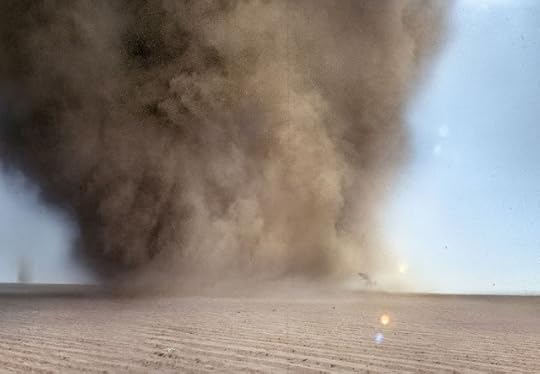
The Tornado Chaser
after Tornado by Francis Alÿs
The tornado chaser is superstitious.
He wears a tornado like a cloak of lightning.
His dreams are dark tunnels with stars slipping down them.
He can find a tornado...

The Tornado Chaser
after Tornado by Francis Alÿs
The tornado chaser is superstitious.
He wears a tornado like a cloak of lightning.
His dreams are dark tunnels with stars slipping down them.
He can find a tornado...
Published on September 21, 2010 11:10
September 6, 2010
Launch of Poetry from Art at Tate Modern
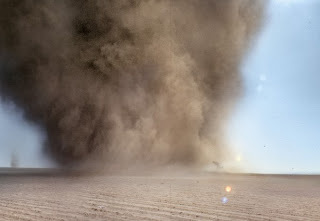 Launch of a pamphlet anthology: Poetry from Art at Tate Modern edited by Pascale Petit18.45 – 21.00 on Saturday 25 September 2010East Room, Level 7, Tate Modern
Launch of a pamphlet anthology: Poetry from Art at Tate Modern edited by Pascale Petit18.45 – 21.00 on Saturday 25 September 2010East Room, Level 7, Tate ModernFree entry, there will be readings, great views, wine. All welcome, booking not required.
(Tornado by Francis Alÿs)
http://www.tate.org.uk/modern/eventseducation/talksdiscussions/22322.htm
This pamphlet anthology of twenty-four poems was written on my Poetry from Art summer course in the galleries at Tate Modern, the third of three...
Published on September 06, 2010 10:14
July 20, 2010
New video of poem from What the Water Gave Me
Here is a new video of me reading 'What the Water Gave Me (VI)', from my new collection
What the Water Gave Me – Poems after Frida Kahlo
:
And here is Frida Kahlo's painting my poem is based on, the very surreal What the Water Gave Me or What I Saw in the Water:

The bathwater contains visionary glimpses from her life and art. There are six poems about this painting in my book, some describe it closely, but in this one I wanted to show her dramatic cremation, when the force of the furnace made...
And here is Frida Kahlo's painting my poem is based on, the very surreal What the Water Gave Me or What I Saw in the Water:

The bathwater contains visionary glimpses from her life and art. There are six poems about this painting in my book, some describe it closely, but in this one I wanted to show her dramatic cremation, when the force of the furnace made...
Published on July 20, 2010 11:27
July 6, 2010
A Poem for Frida Kahlo's Birthday
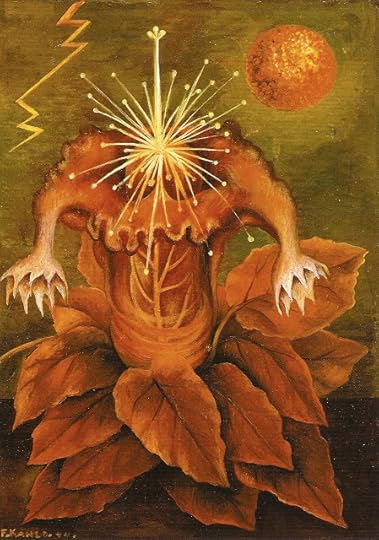
Here is a poem for Frida Kahlo's birthday, from What the Water Gave Me – Poems after Frida Kahlo . 'Flower of Life', like all the poems in my book, has the title of one of her paintings. The Mexican mandrake is a cactus flower and through it Kahlo seems to both celebrate the life force and mourn her inability to have children.
Flower of Life
I flip the love plant upside-down, release a starburst
of stamens and stigma –insecticide yellowto ward off scorpions
from our marriage bed.And...
Published on July 06, 2010 08:08
June 27, 2010
Karen McCarthy's Open Notebooks
The poet Karen McCarthy will be launching her groundbreaking Open Notebooks project this Wednesday 30 June 6.30 – 8.30pm at The Photographers Gallery 16 – 18 Ramillies St, London W1F7 LW. This fascinating online project was commissioned by the literature development agency Spread the Word and explores how writers use the notebook as part of the creative process. Karen interviewed me while I was writing What the Water Gave Me – Poems after Frida Kahlo and has made a video about my drafting...
Published on June 27, 2010 08:13
June 12, 2010
Ruth Padel reviews What the Water Gave Me in the Guardian
Ruth Padel has reviewed What the Water Gave Me: Poems after Frida Kahlo in today's Guardian. I didn't know it was to be reviewed so it's a lovely surprise. Here is an extract:
'Petit's collection is not a verse biography, but a hard-hitting, palette-knife evocation of the effect that bus crash had on Kahlo's life and work. "And this is how I started painting. / Time stretched out its spectrum / and screeched its brakes." WH Auden, in his elegy for Yeats, tells the Irish poet: "Mad Ireland...
'Petit's collection is not a verse biography, but a hard-hitting, palette-knife evocation of the effect that bus crash had on Kahlo's life and work. "And this is how I started painting. / Time stretched out its spectrum / and screeched its brakes." WH Auden, in his elegy for Yeats, tells the Irish poet: "Mad Ireland...
Published on June 12, 2010 03:35



